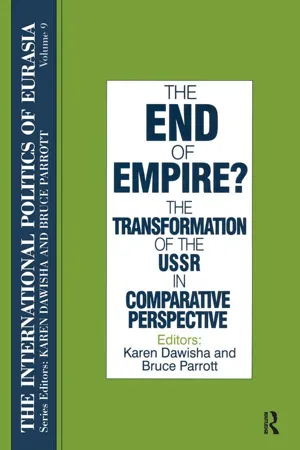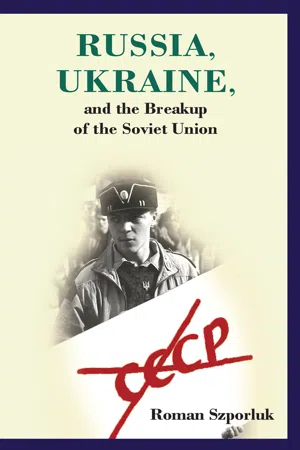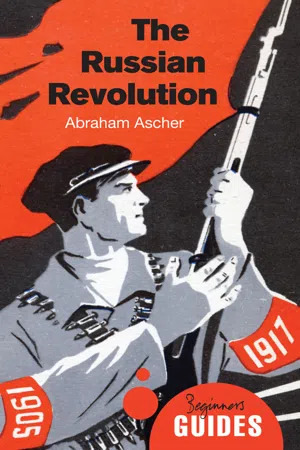History
Fall of Russian Empire
The fall of the Russian Empire refers to the collapse of the Romanov dynasty and the subsequent establishment of the Soviet Union in 1917. This event was marked by widespread social unrest, economic turmoil, and the Bolshevik Revolution, which ultimately led to the end of the centuries-old imperial rule in Russia.
Written by Perlego with AI-assistance
Related key terms
3 Key excerpts on "Fall of Russian Empire"
- S. Frederick Starr, Karen Dawisha(Authors)
- 2016(Publication Date)
- Routledge(Publisher)
II Imperial Disintegration
The Russian Question and Imperial Overextension Roman Szporluk3 The Fall of the Tsarist Empire and the USSRIntroduction
The Russian state collapsed twice in the twentieth century. In 1917, the Russian Empire disintegrated while it was fighting and losing a foreign war. The Soviet Union broke apart in 1991, in peacetime, several decades after it had won the greatest war in Russia’s long history of wars. The first state collapsed before the Communists took power; the second, when it was under Communist rule.Many works have been written—and even more will be written—about causes of the breakup of both the Russian Empire and the USSR.1 Our task here is much more modest—to focus on certain distinct “factors” (“circumstances,” “conditions”) which substantially contributed to these events, without claiming, however, that these are sufficient or necessary “causes” of what happened.Unlike empires of modern times that fell while their former metropoles were gradually being transformed into “normal” nations and nation-states, the tsarist—and then the Soviet—empire fell apart before a modern Russian nation and a Russian nation-state had emerged. A major factor in the imperial collapse in 1917, and in the Soviet collapse in 1991, proved to be conflict between the imperial state and an emergent Russian nation or “society.” In both cases, “Russia” contributed to the fall of “Empire.” This leads us to the conclusion that both empires failed to solve the “Russian Question”—arguably their most important nationality question.Another major factor in the fall of both the Russian and Soviet empires was their overextension. They established their hegemony over nations and territories that refused to recognize Russia and /or the USSR as a superior civilization, a higher form of economy and government—qualities which an empire must possess if its rule is not to be based on coercion alone. To maintain hegemony over them in the absence of such recognition required a disproportionate reliance on coercion, and this made Russian rule in “Europe” a heavy burden on the Russian people, which in turn further contributed to the alienation of the Russians from “their” state. These were additional obstacles to the formation of a modern Russian nation. Thus, the inclusion of non-Russian peoples under Imperial/Soviet rule negatively affected the conditions under which the Russians lived. Having been called—and coerced—by their rulers, both tsarist and Communist, to serve “the great cause” of the empire, the Russians found it very difficult to establish for themselves a political identity distinct from and independent of empire.- Joseph D. Dwyer(Author)
- 2020(Publication Date)
- Hoover Press(Publisher)
16 The Fall of the Tsarist Empire and the USSR: The Russian Question and Imperial OverextensionIntroduction
The Russian state collapsed twice in the twentieth century. In 1917, the Russian Empire disintegrated while it was fighting and losing a foreign war. The Soviet Union broke apart in 1991, in peacetime, several decades after it had won the greatest war in Russia’s long history of wars. The first state collapsed before the Communists took power; the second, when it was under communist rule.Many works have been written—and even more will be written—about causes of the breakup of both the Russian Empire and the USSR.1 Our task here is much more modest—to focus on certain distinct “factors” (“circumstances,” “conditions”) which substantially contributed to these events, without claiming, however, that these are sufficient or necessary “causes” of what happened.Unlike empires of modern times that fell while their former metropoles were gradually being transformed into “normal” nations and nation-states, the tsarist—and then the Soviet—empire fell apart before a modern Russian nation and a Russian nation-state had emerged. A major factor in the imperial collapse in 1917, and in the Soviet collapse in 1991, proved to be conflict between the imperial state and an emergent Russian nation or “society.” In both cases, “Russia” contributed to the fall of “empire.” This leads us to the conclusion that both empires failed to solve the “Russian Question”—arguably their most important nationality question.Another major factor in the fall of both the Russian and Soviet empires was their overextension. They established their hegemony over nations and territories that refused to recognize Russia and/or the USSR as a superior civilization, a higher form of economy and government—qualities an empire must possess if its rule is not to be based on coercion alone. To maintain hegemony over them in the absence of such recognition required a disproportionate reliance on coercion, and this made Russian rule in “Europe” a heavy burden on the Russian people, which in turn further contributed to the alienation of the Russians from “their” state. These were additional obstacles to the formation of a modern Russian nation. Thus, the inclusion of non-Russian peoples under Imperial/Soviet rule negatively affected the conditions under which the Russians lived. Having been called—and coerced—by their rulers, both tsarist and communist, to serve “the great cause” of the empire, the Russians found it very difficult to establish for themselves a political identity distinct from and independent of empire.- eBook - ePub
The Russian Revolution
A Beginner's Guide
- Abraham Ascher(Author)
- 2014(Publication Date)
- Oneworld Publications(Publisher)
3 The collapse of tsarismFor about a decade after the dissolution of the Second Duma, the Russian leadership did not face a mass movement bent on overturning the tsarist regime, but the political waters were not entirely calm. Unrest in the countryside surfaced periodically, and strikes by workers in various industrial regions were not uncommon. The most dramatic broke out in 1912 in the Lena Goldfields in Siberia, which the army crushed with terrifying brutality, killing some two hundred workers. Far from ending worker unrest, this cruelty spurred workers in other parts of the country to stage strikes during which they voiced economic as well as political demands. In July 1914, a strike movement that often involved violence engulfed various regions. At no time until 1917 did the authorities face the kind of danger to the stability of the state that they had confronted in 1905.World War I
Once again, the decisive factor in turning deep discontent into revolutionary action was a military conflict that exposed Russia’s weakness and recklessness, and caused untold suffering to millions of ordinary citizens. One of the curious aspects of World War I is that no responsible leader wanted to lead his country into battle; if in 1914 the monarchs and ministers had had any inkling of the consequences of the war, they probably would not have given their armies the order to march. When the fighting ended four years later, millions of people had perished, three monarchs had lost their thrones, national boundaries had been changed, often arbitrarily, revolutions had erupted in several countries, and the ensuing bitterness throughout Europe had set the stage for yet another world war even more costly in every respect than the first one.Ideology, as much as anything else, dictated the policy of Russian statesmen and of Tsar Nicholas II during the international crisis that erupted on 15 June (commonly noted as 28 June in the Gregorian calendar) 1914. On that day, the Archduke Franz Ferdinand, heir to the Habsburg throne, was assassinated, together with his wife, in Sarajevo, the capital of Bosnia, a province populated by Slavs that Austria-Hungary had annexed in 1908. The government in Vienna concluded that the assassination was part of a plan by Serbia to gain control over Bosnia and to establish a new state, Yugoslavia, which was to embrace all southern Slavs. The Austro-Hungarian statesmen feared such a development, because it would most likely lead to the unraveling of their multinational state. They therefore decided on a provocative and aggressive step. They sent an ultimatum to Serbia demanding not only the suppression of all anti-Austrian agitation but also the participation of Austrians in the crackdown. No sovereign government could accept such conditions, and Serbia was no exception. On 15 July (commonly noted as 28 July in the Gregorian calendar), Austria-Hungary declared war on Serbia.
Learn about this page
Index pages curate the most relevant extracts from our library of academic textbooks. They’ve been created using an in-house natural language model (NLM), each adding context and meaning to key research topics.


